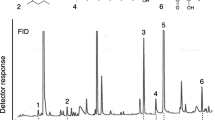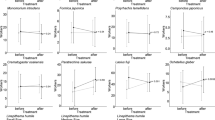Summary
The behaviour of adultHomoeusa acuminata on trails of its hostLasius fuliginosus was investigated both in the field and in the laboratory. The beetles were active from May to September, accurately following the foraging trails of their hosts up to 20 metres from the nest. Most of the time, they were ignored by the ants, but if attacked they raised their abdomen as a possible appeasement or defensive behaviour. On trails the beetles most probably act as food robbers, feeding on prey collected by ants. The following method, called stowaway behaviour, was used by the beetles: when a beetle encountered an ant carrying a prey back to the nest it jumped on the prey, probably feeding on it while being transported.
Laboratory experiments on circular artificial trails demonstrated thatH. acuminata follows a water extract of hindguts of the ants, the source of the trail pheromone. Both beetles and ants responded to an artificial trail of 0.03 hindgut equivalent per cm, but the mean distance followed by the beetles was about twelve times higher than that covered by the ants themselves. In contrast, experiments with solutions of the six fatty acids reported as the active components of the trail pheromone showed that the beetles did not respond at all, and that the ants only respond to the fatty acids at a very high concentration.
Similar content being viewed by others
References
Akre, R. D. and C. W. Rettenmeyer, 1966. Behavior of Staphilinidae associated with army ants (Formicidae, Ecitonini).J. Kans. Entomol. Soc. 39:745–782.
Akre, R. D. and C. W. Rettenmeyer, 1968. Trail following by guests of army ants (Hymenoptera: Formicidae, Ecitonini).J. Kans. Entomol. Soc. 41:165–174.
Cammaerts, R., C. Detrain and M. C. Cammaerts, 1990. Host trail following by the myrmecophilous beetleEdaphopaussus favieri (Fairmaire) (Carabidae: Paussinae).Insects Soc. 37:200–211.
Carthy, J. D., 1951. The orientation of two allied species of British ant, II. Odour trail laying and following inAcanthomyops (Lasius)fuliginosus.Behaviour 3:304–318.
Dobrzanska, J., 1966. The control of the territory byLasius fuliginosus Latr.Acta Biol. exp. Vars. 26:193–213.
Donisthorpe, H. St. J. K., 1927.The guests of British ants, their habits and life histories. George Routledge & Sons, London, xxiii + 244pp.
Hangartner, W., 1967. Spezifität und Inaktivierung des Spurpheromons vonLasius fuliginosus Latr. und Orientierung der Arbeiterinnen im Duftfeld.Z. vergl. Physiol. 57:103–136.
Hangartner, W. and S. Bernstein, 1964. Über die Geruchsspur vonLasius fuliginosus zwischen Nest und Futterquelle.Experentia 20:392–393.
Henderson, G. and R. D. Akre, 1986. Biology of the myrmecophilous cricket,Myrmecophila manni (Orthoptera: Grillidae).J. Kansas Entomol. Soc. 59:454–467.
Hennaut-Riche, Bl., G. Josens and J. M. Pasteels, 1980. L'approvisionnement du nid chezLasius fuliginosus: pistes, cycles d'activité et spécialisation territoriale des ouvrières.C. R. UIEIS (Lausanne):71–78.
Hölldobler, B., 1968. Der Glanzkäfer als “Wegelagerer” an Ameisenstrassen.Naturwissenschaften 55:397.
Hölldobler, B., 1971. Communication between ants and their guests.Scientific Am. 224:86–93.
Hölldobler, B., M. Möglich and U. Maschwitz, 1981. Myrmecophilic relationship ofPella (Coleoptera: Staphylinidae) toLasius fuliginosus (Hymenoptera:Formicidae).Psyche 88:347–374.
Huwyler, S., K. Grob and M. Viscontini, 1975. The trail pheromone of the ant,Lasius fuliginosus: identification of six components.J. Insect Physiol. 21:299–384.
Moser, J. C., 1964. Inquiline Roach Responds to Trail Marking Substance of Leafcutting Ants.Science 143:1048–1049.
Pasteels, J. M., 1968. Le système glandulaire tégumentaire des Aleocharinae (Coleoptera, Staphylinidae) et son évolution chez les espèces termitophiles du genreTermitella.Archives de Biologie, Liège 79:381–469.
Quinet, Y. and J. M. Pasteels, 1991. Spatiotemporal evolution of the trail network inLasius fuliginosus (Hymenoptera, Formicidae).Belg. J. Zool. 121:55–72.
Author information
Authors and Affiliations
Rights and permissions
About this article
Cite this article
Quinet, Y., Pasteels, J.M. Trail following and stowaway behaviour of the myrmecophilous staphylinid beetle,Homoeusa acuminata, during foraging trips of its hostLasius fuliginosus (Hymenoptera: Formicidae). Ins. Soc 42, 31–44 (1995). https://doi.org/10.1007/BF01245697
Received:
Revised:
Accepted:
Issue Date:
DOI: https://doi.org/10.1007/BF01245697




